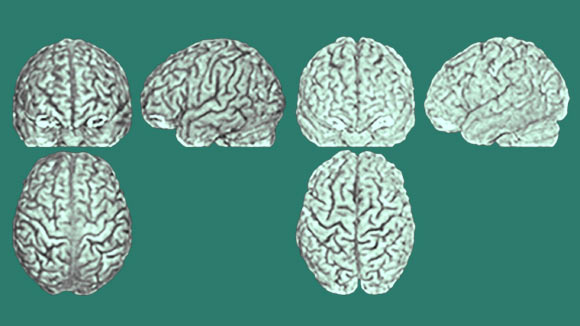Every individual has a unique brain anatomy, according to new research from the University of Zurich in Switzerland; and this uniqueness is the result of a combination of genetic factors and individual life experiences.

Three scans (from the front, side and above) of two different brains (pictured on the left and on the right) belonging to twins; the furrows and ridges are different in each person. Image credit: Lutz Jäncke, University of Zurich.
“As no two fingerprints are the same, they have become the go-to method of identity verification for police, immigration authorities and smartphone producers alike,” said University of Zurich’s Professor Lutz Jäncke and co-authors.
“But what about the central switchboard inside our heads? Is it possible to find out who a brain belongs to from certain anatomical features?”
In earlier studies, the scientists had already been able to demonstrate that individual experiences and life circumstances influence the anatomy of the brain.
“Professional musicians, golfers or chess players, for example, have particular characteristics in the regions of the brain which they use the most for their skilled activity,” they said.
“However, events of shorter duration can also leave behind traces in the brain: if, for example, the right arm is kept still for two weeks, the thickness of the brain’s cortex in the areas responsible for controlling the immobilized arm is reduced.”
“We suspected that those experiences having an effect on the brain interact with the genetic make-up so that over the course of years every person develops a completely individual brain anatomy, Professor Jäncke said.
To investigate their hypothesis, he and his colleagues examined the brains of 191 healthy people using magnetic resonance imaging three times over a period of two years.
Over 450 brain anatomical features were assessed, including very general ones such as total volume of the brain, thickness of the cortex, and volumes of gray and white matter.
For each study participant, the researchers were able to identify an individual combination of specific brain anatomical characteristics, whereby the identification accuracy, even for the very general brain anatomical characteristics, was over 90%.
“With our study we were able to confirm that the structure of people’s brains is very individual,” Professor Jäncke said.
“The combination of genetic and non-genetic influences clearly affects not only the functioning of the brain, but also its anatomy.”
The findings were published in the April 4, 2018 issue of the journal Scientific Reports.
_____
Seyed Abolfazl Valizadeh et al. 2018. Identification of individual subjects on the basis of their brain anatomical features. Scientific Reports 8, article number: 5611; doi: 10.1038/s41598-018-23696-6







